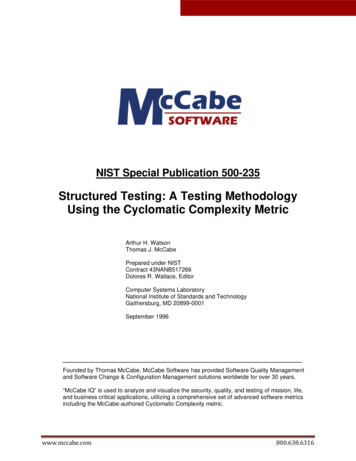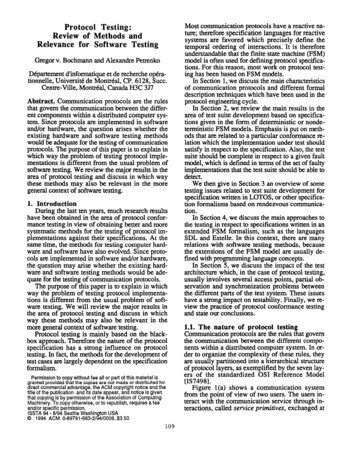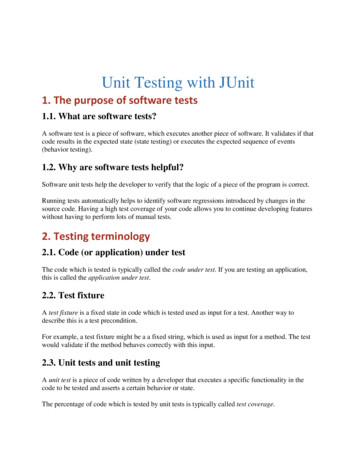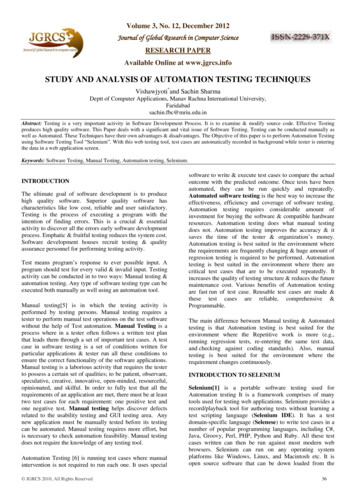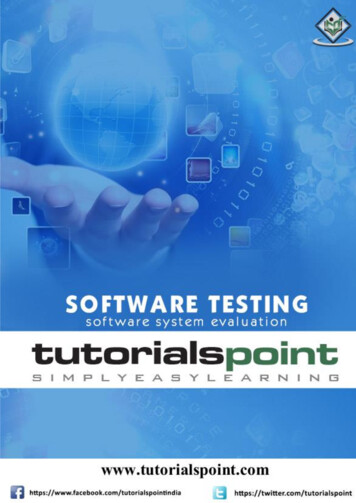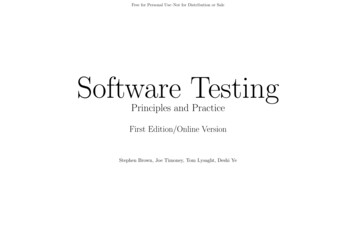
Transcription
Free for Personal Use–Not for Distribution or SaleSoftware TestingPrinciples and PracticeFirst Edition/Online VersionStephen Brown, Joe Timoney, Tom Lysaght, Deshi Ye
Free for Personal Use–Not for Distribution or SaleiSoftware TestingPrinciples and PracticeFirst EditionA collaboration between the Department of Computer Science, NUI Maynooth, Ireland, and the College of Computer Science, Zhejiang University, ChinaAuthorized English language edition entitled “Software Testing: Principles and Practice” by Stephen Brown, Joe Timoney, Tom Lysaght, Deshi Ye.All rights reserved. No part of this book may be reproduced or transmitted in any form or by any means, electronic or mechanic, including photocopying, recording, or byany information storage retrieval system, without the permission of Stephen Brown, Joe Timoney, Tom Lysaght, Deshi Ye.English language edition published by China Machine Press.Copyright 2011 by China Machine Press.This edition is manufactured in the People’s Republic of China, and is authorized for sale and distribution Worldwide.
Free for Personal Use–Not for Distribution or SalePrefaceThis book is based on a series of lectures given at the National University of Ireland, Maynooth and Zhejiang University. It provides a textbook for a number of courses,describing the fundamentals of software testing. The material has been developed over the past ten years, and reflects both the experiences from 20 years in industry fromone of the authors, and the authors’ joint experiences in lecturing.There is no one standard textbook on software testing, and this book is the result of many years of extracting and interpreting test techniques from a wide and variednumber of sources. These include testing classics such as The Art of Software Testing by Myers, Software Testing by Roper, and Testing Object-Oriented Systems by Binder;standard textbooks such as Software Engineering by Pressman and Ince, and Software Engineering by Somerville; software process books such as Software Testing in the RealWorld by Kit and extreme Programming explained by Beck; and ISO and IEEE standards related to software quality and testing.Software testing is a challenging task – it is as important for businesses and government as it is for research institutions. It is still as much an art as a science: thereare no accepted standards or norms for applying the various techniques, and interpretation is required. There is no well established research on the effectiveness of differentapproaches. The techniques are easy to understand, but generally difficult to apply to real-world software. By providing extensive worked examples, this book aims to providea solid basis for both understanding, and applying, various test techniquesii
Free for Personal Use–Not for Distribution or � Myers 的《软件测试的艺术》、Roper 的《软件测试》、Binder �工程教材如Pressman 和 Ince 的《软件工程》、Somerville 的《软件工程》;软件过程类书籍如 Kit 的《现实世界中的软件测试》、Beck �关的 ISO 和 IEEE 供一个坚实的基础。
Free for Personal Use–Not for Distribution or SaleContentsPreface1 Introduction1.1 The Software Industry . . . . . . . . . . . .1.2 Software Testing and Quality . . . . . . . .1.3 Errors, Faults and Failures . . . . . . . . .1.3.1 Software Faults . . . . . . . . . . . .1.3.2 Software Failures . . . . . . . . . . .1.3.3 Need for Testing . . . . . . . . . . .1.4 The Role of Specifications . . . . . . . . . .1.5 Overview of Testing . . . . . . . . . . . . .1.5.1 Testing in the Development Process1.5.2 Test Automation . . . . . . . . . . .1.6 The Theory of Testing . . . . . . . . . . . .1.6.1 Exhaustive Testing Example . . . .1.6.2 Implications . . . . . . . . . . . . . .1.7 When To Finish Testing . . . . . . . . . . .1.8 Notes on Book Structure . . . . . . . . . .ii.1123345899910101011112 Principles of Software Testing2.1 Dynamic and Static Verification . . . . . . . .2.1.1 Static Verification . . . . . . . . . . . .2.1.2 Dynamic Verification . . . . . . . . . . .2.2 Black-Box and White-Box Testing . . . . . . .2.2.1 Errors of “Omission” and “Commission”2.3 Test Approaches . . . . . . . . . . . . . . . . .2.3.1 Black-Box Testing . . . . . . . . . . . .2.3.2 White-Box Testing . . . . . . . . . . . .2.3.3 Fault Insertion . . . . . . . . . . . . . .13131313141516161718.iv
Free for Personal Use–Not for Distribution or 383940403 Unit Testing3.1 Introduction . . . . . . . . . . . . . . . . . . . .3.2 Usage . . . . . . . . . . . . . . . . . . . . . . . .3.3 Black-Box Techniques . . . . . . . . . . . . . . .3.3.1 Equivalence Partitioning (EP) . . . . . .3.3.2 Boundary Value Analysis (BVA) . . . . .3.3.3 Testing Combinations of Inputs (CI) . . .3.3.4 Testing Sequences of Inputs (SI) or State3.3.5 Random Input Data (RID) . . . . . . . .3.3.6 Error Guessing (EG) . . . . . . . . . . . .3.4 White-Box Techniques . . . . . . . . . . . . . . .3.4.1 Statement Coverage (SC) . . . . . . . . .3.4.2 Branch Coverage (BC) . . . . . . . . . . .3.4.3 Condition Coverage (CC) . . . . . . . . .3.4.4 Decision Condition Coverage (DCC) . . .3.4.5 Multiple Condition Coverage (MCC) . . .3.4.6 Path Coverage (PC) . . . . . . . . . . . .3.4.7 d-u pair Coverage (DUP) . . . . . . . . est Activities . . . . . . . . . . . . .2.4.1 Analysis Outputs . . . . . . . .2.4.2 Test Cases . . . . . . . . . . . .2.4.3 Test Data . . . . . . . . . . . .2.4.4 Test Code (or Test Procedures)Analysis of Software Specifications . .2.5.1 Parameters . . . . . . . . . . .2.5.2 Parameter Ranges . . . . . . .2.5.3 Equivalence Partitions . . . . .2.5.4 Boundary Values . . . . . . . .2.5.5 Combinations of Values . . . .2.5.6 Sequences of Values . . . . . .Analysis of Software Components . .2.6.1 Control Flow Graphs . . . . . .2.6.2 Decisions and Conditions . . .2.6.3 Paths . . . . . . . . . . . . . .2.6.4 Data-Flow Testing . . . . . . .2.6.5 Ranking . . . . . . . . . . . . .Analysis of Targets for Fault Insertion2.7.1 Offutt’s 5 Sufficient MutationsTest Artefacts . . . . . . . . . . . . .v.
Free for Personal Use–Not for Distribution or SaleCONTENTS3.5viFault Insertion . . . . . . . . . . . . . . . . . . . . . . . . . . . . . . . . . . . . . . . . . . . . . . . . . . . . . . . . . . . . . . . . . . . . . . . . . . . . . . . . .3.5.1 Strong Mutation Testing (SMT) . . . . . . . . . . . . . . . . . . . . . . . . . . . . . . . . . . . . . . . . . . . . . . . . . . . . . . . . . . . . . . . . . . .4 Unit Testing Examples4.1 Example One: seatsAvailable() . . .4.1.1 Description . . . . . . . . . .4.1.2 Specification . . . . . . . . .4.1.3 Source Code . . . . . . . . .4.1.4 Equivalence Partitioning . . .4.1.5 Boundary Value Analysis . .4.1.6 Combinational Testing . . . .4.1.7 Tests . . . . . . . . . . . . . .4.1.8 Using Random Test Data . .4.1.9 Statement Coverage . . . . .4.1.10 Branch Coverage . . . . . . .4.1.11 Condition Coverage . . . . .4.1.12 Decision/Condition Coverage4.1.13 Multiple Condition Coverage4.1.14 Path Coverage . . . . . . . .4.1.15 D-U pair Coverage . . . . . .4.1.16 Strong Mutation Testing . . .4.2 Example Two: premium() . . . . . .4.2.1 Description . . . . . . . . . .4.2.2 Specification . . . . . . . . .4.2.3 Source Code . . . . . . . . .4.2.4 Equivalence Partitioning . . .4.2.5 Boundary Value Analysis . .4.2.6 Combinational Testing . . . .4.2.7 Statement Coverage . . . . .4.2.8 Branch Testing . . . . . . . .4.2.9 Condition Coverage . . . . .4.2.10 Multiple Condition Coverage4.2.11 Path Testing . . . . . . . . .4.2.12 d-u pair Testing . . . . . . .4.2.13 Strong Mutation Testing . . .585860. 60. 60. 61. 61. 61. 64. 66. 67. 67. 69. 71. 72. 73. 74. 75. 76. 77. 79. 79. 79. 80. 80. 82. 84. 87. 89. 91. 96. 100. 101. 1035 Static Verification5.1 Design Reviews . . . . . . . . . . . . . . . . . . . . . . . . . . . . . . . . . . . . . . . . . . . . . . . . . . . . . . . . . . . . . . . . . . . . . . . . . . . . . . . . .5.1.1 Informal Walk-through . . . . . . . . . . . . . . . . . . . . . . . . . . . . . . . . . . . . . . . . . . . . . . . . . . . . . . . . . . . . . . . . . . . . . . . . .5.1.2 Formal Design Review . . . . . . . . . . . . . . . . . . . . . . . . . . . . . . . . . . . . . . . . . . . . . . . . . . . . . . . . . . . . . . . . . . . . . . . . .106106106106
Free for Personal Use–Not for Distribution or SaleCONTENTS5.2viiStatic Code Analysis . . . . . . . . . . . . . . . . . . . . . . . . . . . . . . . . . . . . . . . . . . . . . . . . . . . . . . . . . . . . . . . . . . . . . . . . . . . . . . 1075.2.1 Walk-throughs . . . . . . . . . . . . . . . . . . . . . . . . . . . . . . . . . . . . . . . . . . . . . . . . . . . . . . . . . . . . . . . . . . . . . . . . . . . . . 1075.2.2 Code Inspections . . . . . . . . . . . . . . . . . . . . . . . . . . . . . . . . . . . . . . . . . . . . . . . . . . . . . . . . . . . . . . . . . . . . . . . . . . . . 1086 Testing Object-Oriented Software6.1 Characteristics Of Object-Oriented Software6.2 Effects Of OO On Testing . . . . . . . . . . .6.3 Object Oriented Testing Models . . . . . . .6.3.1 Conventional Models . . . . . . . . . .6.3.2 Combinational Models . . . . . . . . .6.3.3 State Machine Models . . . . . . . . .6.3.4 Specification & Design Models . . . .6.3.5 Built-In-Test . . . . . . . . . . . . . .6.4 Example . . . . . . . . . . . . . . . . . . . .6.4.1 Class CarTax . . . . . . . . . . . . . .6.4.2 Black-Box Testing in Class Context .6.4.3 White-Box Testing in Class Context .6.4.4 Combinational Testing . . . . . . . . .6.4.5 State-Machine Testing . . . . . . . . .6.4.6 Specification/Design Testing . . . . .6.4.7 Built-In Testing . . . . . . . . . . . . 267 Integration and System Testing7.1 Integration Testing . . . . . . . . . . . .7.1.1 Drivers and Stubs . . . . . . . .7.1.2 Top-Down Integration . . . . . .7.1.3 Bottom-Up Integration . . . . .7.1.4 Sandwich Integration . . . . . . .7.1.5 End-to-end User Functionality .7.1.6 Test Cases . . . . . . . . . . . . .7.1.7 Conclusion . . . . . . . . . . . .7.2 System Testing . . . . . . . . . . . . . .7.2.1 System Test Categories . . . . .7.2.2 System Level Functional Testing7.2.3 Test Cases . . . . . . . . . . . . .7.2.4 GUI Example . . . . . . . . . . .7.3 Field Testing and Acceptance Testing .128128128130132133133134135135135136141141148.8 Software Test Automation1498.1 Coverage Measurement . . . . . . . . . . . . . . . . . . . . . . . . . . . . . . . . . . . . . . . . . . . . . . . . . . . . . . . . . . . . . . . . . . . . . . . . . . . . 149
Free for Personal Use–Not for Distribution or SaleCONTENTS8.28.38.48.58.68.7viii8.1.1 Lazy Evaluation . . . . . . . . . . .JUnit . . . . . . . . . . . . . . . . . . . . .8.2.1 JUnit Example . . . . . . . . . . . .8.2.2 Test Documentation . . . . . . . . .JUnit Testing in an IDE . . . . . . . . . . .Regression/Inheritance Testing With JUnitWriting Your Own Test Runner . . . . . .Mutation Testing . . . . . . . . . . . . . . .Automated System Testing . . . . . . . . .9 Testing in the Software Process9.1 Test Planning . . . . . . . . . . . . . . . .9.2 Software Development Life Cycle . . . . .9.3 The Waterfall Model . . . . . . . . . . . .9.4 The V-Model . . . . . . . . . . . . . . . .9.5 Incremental and Agile Development . . .9.5.1 Incremental Development . . . . .9.5.2 Extreme Programming . . . . . . .9.5.3 SCRUM . . . . . . . . . . . . . . .9.5.4 Synch And Stabilize . . . . . . . .9.5.5 Process-Related Quality Standards9.6 Repair-Based Testing . . . . . . . . . . .9.6.1 Specific Repair Test . . . . . . . .9.6.2 Generic Repair Test . . . . . . . .9.6.3 Abstracted Repair Test . . . . . .9.6.4 Example . . . . . . . . . . . . . . .9.6.5 Repair-Based Test Suites . . . . .150150151152154154157158158. . . . . . . . . . . . . . . . . . . . . . . . . . . . . . . . . . . . . . . . . . . . . . . . . . . . . . .and Models. . . . . . . . . . . . . . . . . . . . . . . . . . . . . . . . . . . . 79.18018018018118118118318318418418518610 Advanced Testing Issues10.1 Philosophy of Testing . . . . . . . . . . . .10.2 Test Technique Selection . . . . . . . . . .10.3 Inserting Data Faults . . . . . . . . . . . .10.4 Design For Testability (DFT) . . . . . . . .10.5 Testing with Floating Point Numbers . . .10.6 Unit Testing of GUI Components . . . . . .10.7 Testing with Complex Data Structures . .10.8 Automated Random Testing . . . . . . . .10.9 Automated Statement and Branch Testing10.10 Overlapping and Discontinuous Partitions .10.11 Handling Relative Values . . . . . . . . . .
Free for Personal Use–Not for Distribution or SaleCONTENTSix10.11.1 Classic Triangle Problem . . . . .10.12 Pairwise Testing . . . . . . . . . . . . . .10.13 Testing Boundary Crossings (BX) . . . .10.14 Varying Input Parameters . . . . . . . . .10.15 Extended Combinational Testing . . . . .10.15.1 No “Don’t-Care”s . . . . . . . . .10.15.2 Test “Don’t-Care”s Individually .10.16 Including Testing In The Build Procedure10.17 Testing Concurrent and Parallel Software10.17.1 Unit Testing . . . . . . . . . . . .10.17.2 System Testing . . . . . . . . . . .10.17.3 Static Analysis . . . . . . . . . . .10.17.4 Tools . . . . . . . . . . . . . . . .10.18 Testing Embedded Software . . . . . . . .10.19 Testing Network Protocol Processing . . .10.19.1 Text-Based Protocols . . . . . . .10.19.2 Binary Protocols . . . . . . . . . .10.19.3 Protocol Stacks and DFT . . . . .10.20 Research Directions . . . . . . . . . . . 97197197APPENDICESA TerminologyB ExercisesB.1 JUnit and Eclipse . . . . .B.2 Unit Test - Exercise 1 . . .B.3 Unit Test - Exercise 2 . . .B.4 Unit Test - Exercise 3 . . .B.5 Unit Test - Exercise 4 . . .B.6 Unit Test - Exercise 5 . . .B.7 Unit Test - Exercise 6 . . .B.8 Unit Test - Exercise 7 . . .B.9 Unit Test - Exercise 8 . . .B.10 Unit Test - Exercise 9 . . .B.11 Exercise 10 - Test lect Bibliography213ERRATA214
Free for Personal Use–Not for Distribution or SaleList of Figures1.11.21.31.41.5Failure Rate for a Software Product over its Lifecycle .Ideal Project Progression using Forward Engineering .Realistic Project Progression including Checks . . . .Verification in the Development Process . . . . . . . .Validation in the Development Process . . . . . . . . .142.152.162.17Software Tests Procedure . . . .Specification Model of Testing . .Implementation Model of TestingNatural Ranges . . . . . . . . . .Equivalence Partitions . . . . . .State Diagram for counter . . . .CFG for Sequence . . . . . . . .CFG for Selection (if-then) . . .CFG for Selection (if-then-else) .CFG for Selection (switch) . . . .CFG for Iteration (while) . . . .CFG for Iteration (do-while) . .CFG for Iteration (for) . . . . . .Paths for condIsNeg() . . . . . .CFG for Basis Paths Example . .Coverage Criteria Ranking . . . .Test Components . . . . . . . . .14171821222931313232333334353739403.1CC without BC . . . . . . . . . . . . . . . . . . . . . . . . . . . . . . . . . . . . . . . . . . . . . . . . . . . . . . . . . . . . . . . . . . . . . . . . . . . . . . . . .544.14.2CFG for seatsAvailable() . . . . . . . . . . . . . . . . . . . . . . . . . . . . . . . . . . . . . . . . . . . . . . . . . . . . . . . . . . . . . . . . . . . . . . . . . . . .CFG for premium() . . . . . . . . . . . . . . . . . . . . . . . . . . . . . . . . . . . . . . . . . . . . . . . . . . . . . . . . . . . . . . . . . . . . . . . . . . . . . .70885.1Sample Code Inspection Checklist . . . . . . . . . . . . . . . . . . . . . . . . . . . . . . . . . . . . . . . . . . . . . . . . . . . . . . . . . . . . . . . . . . . . . . 109.
Software Testing Principles and Practice First Edition/Online Version Stephen Brown, Joe Timoney, Tom Lysaght, Deshi Ye. Free for Personal Use{Not for Distribution or Sale . First Edition A collaboration between the Department of Computer Science, NUI Maynooth, Ireland, and the College of Computer Science, Zhejiang University, China .




